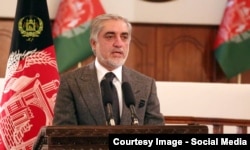KABUL -- The top U.S. commander in Afghanistan said his decision to use one of the U.S. military's largest nonnuclear bombs in an attack that reportedly killed 36 Islamic State (IS) militants was done in communication with officials in Washington.
General John Nicholson said April 14 at a news conference in Kabul that the attack was purely "tactical."
"This was the right weapon for the right target," he told reporters.
Afghan Defense Ministry spokesman Dawlat Waziri said 36 IS fighters were killed in the blast which hit an IS tunnel and command center on April 13. He said no civilians were harmed.
The death toll could not be independently confirmed.
U.S. and Afghan security forces swarmed over the target site and did not allow reporters or local residents to approach the area April 14.
"We have U.S. forces at the site and we see no evidence of civilian casualties nor have there been reports," Nicholson said. "Let me be clear -- we will not relent in our mission to destroy [IS in Afghanistan].... There will be no sanctuary for terrorists in Afghanistan."
Media reports also said senior IS commander Siddiq Yar was among those killed.
IS issued a statement through its affiliated Amaq news agency denying “any dead or wounded from yesterday's American strike in Nangarhar.”
The Pentagon said it was the first-ever combat use of the GBU-43/B bomb. The 9,797-kilogram bomb was dropped from an MC-130 aircraft in the Achin district of the eastern province of Nangarhar bordering Pakistan. It targeted a complex of tunnels that Afghan and U.S. officials said was being used by militants linked to IS.
Afghanistan's presidency said the bomb was dropped in coordination with the government, adding that "the air strike was designed to support the efforts of the ANSF (Afghan National Security Force) and U.S. forces" conducting an operation in the area.
A spokesman for President Ashraf Ghani told Radio Free Afghanistan the decision to deploy the massive bomb in the area was made after repeated air strikes by the Afghan Air Force and the NATO-led Resolute Support Mission's air force had failed to destroy the IS hideout.
The tunnel network included the IS regional command center and weapons depots dug underground at depths that reached 300 meters in some areas, Dawakhan Meenapal, Ghani's deputy spokesman, said.
"Therefore, in consultation with the Afghan government, the final decision to hit that area was finalized in the presence of the Afghan military leadership and officials who were visiting Nangarhar Province yesterday (April 13)."
Meenapal also stressed that the final decision was made "knowing that there were no civilians in the area."
Abdullah Abdullah, the chief executive officer of Afghanistan, confirmed the attack had been carried out in coordination with the government and that "great care had been taken to avoid civilian harm."
Officials hope the bombing will diminish IS's capabilities in Afghanistan and to also send a warning to the much larger Taliban militant group ahead of their annual spring offensive.
The Taliban issued a statement denouncing the bombing.
"Using this massive bomb cannot be justified and will leave a material and psychological impact on our people," the Taliban, who compete with IS in the country, said in a statement.
However, former Afghan President Hamid Karzai condemned the use of the bomb on Afghan soil. "This is not the war on terror, but the inhuman and most brutal misuse of our country as testing ground for new and dangerous weapons," he said on Twitter.
A day after the attack, residents of surrounding villages told Radio Free Afghanistan the targeted region had housed many IS fighters and that the blast shook the ground around their homes in the remote mountainous area.
“It was a very powerful and horrific bomb,” one resident, who declined to give his name, told RFE/RL. ”It shook the whole area, including Asadkhel village.”
“The place where the bomb exploded was the center of Islamic State,” another resident said. “There is a big tunnel over there, which they used for hiding and for holding prisoners and weapons.”
He added that when IS militants had arrived in the area, they took over their homes and “looted everything.... Now their own families live there."
The strike came as U.S. President Donald Trump dispatched his first high-level delegation to Kabul, amid uncertainty about his plans for the some 8,400 American troops stationed in Afghanistan.
It also follows last week's death of a U.S. special forces soldier fighting IS militants in Nangarhar Province.
The GBU-43/B Massive Ordnance Air Blast Bomb (MOAB), known as "the mother of all bombs," unleashes 11 tons of explosives.
Trump has told reporters that the bombing was “another very, very successful mission.” He did not answer directly when asked if he had authorized the use of the bomb.
“Everyone knows exactly what happened. What I do is authorize my military. We have given them total authorization,” Trump said.
The GBU-43/B bomb was developed for use in the Iraq war -- at a reported cost of $16 million each -- and was first tested in 2003, but never used in action until April 13.
The MOAB is the U.S. military's most powerful nonnuclear bomb. However, it is not the heaviest. The Massive Ordnance Penetrator, or MOP, is an even bigger bunker-buster bomb which weighs a colossal 13,600 kilograms.
With additional reporting by AP, AFP, dpa, and Reuters











